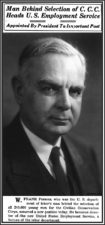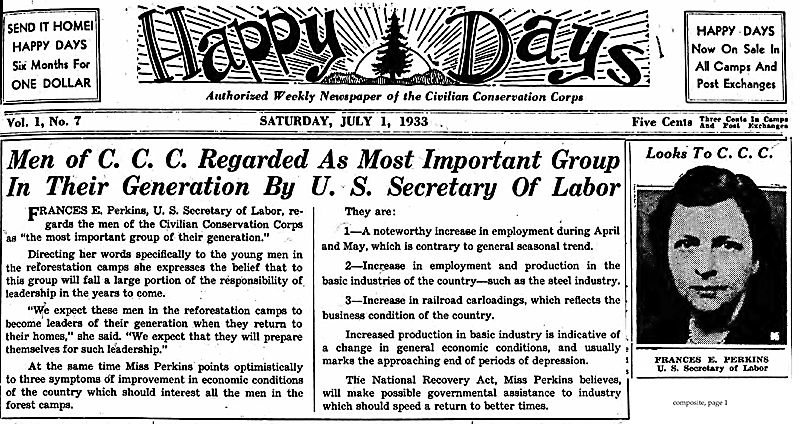Architect of the Civilian Conservation Corps Frances Perkins
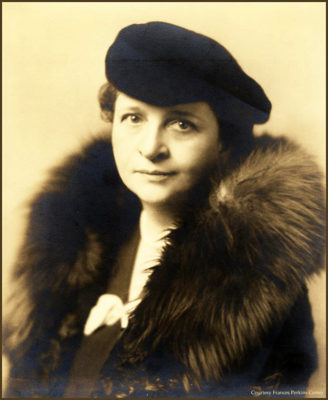
The professional partnership of Franklin Delano Roosevelt (FDR) and Frances Perkins was strengthened during Roosevelt’s 1929 – 1932 term as governor of New York. Recognizing Perkins understanding and grasp of complex government policies he appointed her Commissioner of New York State Industrial Commission. In this position Perkins supervised the health and safety of state workers; an appointment she managed with little difficulty. As a seasoned social worker, activist for public works, child labor, unemployment insurance, and workers’ rights advocate Perkins was able to tutor the then governor on the concept of “social insurance”.
First Woman Secretary of Labor
When FDR became President he selected “Miss Perkins” to be Secretary of Labor; the first woman ever appointed to a US cabinet position. Her tenure, as one of his closest and trusted advisers, would span FDR’s entire four term administration. A unique position which allowed her to observe, assist and analyze “the most complicated human being I ever knew.”
Theirs was a remarkable collaboration; one which empowered Perkins to frame and develop several of FDR’s New Deal programs and policies, among them the first and most successful, the Civilian Conservation Corps (CCC).
Perkins likened the president’s method of getting things done, “to put dynamite under the people who had to do the job and let them fumble for their own methods.”
This great brainstorm about giving the unemployed relief by taking them out into the woods to do forestry work. I first heard about this from the mouth of Franklin Roosevelt, without any preparation at all. . . I thought it was a pipe dream. . . Already my mind had begun to work on who the unemployed were, how you were going to get them to the places where they were going, how they would know what to do when they got there. . . He thought you could just take everybody who was applying for relief and put them in the forests . . . He just thought of all the unemployed, not just of the young men. The young men were my idea later…
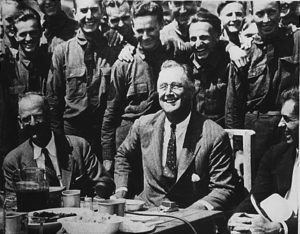
It was very complicated. I said, “How are you going to recruit? If you’re going to pay them money, how are you going to get them?” He said, “Use your employment service.” I said, “Mr. President, we haven’t got an employment service . . .” He said, “Make one. Create one.” By this time, I began to throw in some other ideas.
Collaborating Agencies – Advising the President
It was agreed that the forest work projects should be directed by the Departments of Interior and Agriculture. Perkins collaborated and consulted with George Dern, Director of the Department of War and brought in Frank Persons, as the Labor Department CCC representative. Frank Persons possessed invaluable insight because of his “WW I Red Cross experience… he knew how to handle an organization which was nationwide and which had to be alerted at a moment’s notice for disaster relief or special relief in emergency quarters. This was an emergency operation, all right.”
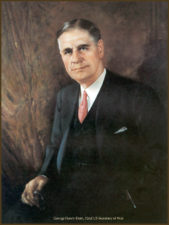
Douglas Granville Chandor
Secretary of Labor Frances Perkins found support and guidance when she teamed with W. Frank Persons (left), and Secretary of War George Dern (right). She felt they were invaluable to the successful formation and organization of the CCC.
With this counsel and cooperation Perkins was better able to make sensible suggestions and advise the president…
“What do you think about this? We’ve got a big military establishment in this country. It isn’t busy. It’s a stand- by organization. They must have trucks. Mr. President, they must have tents. They must have cots. They must have blankets. They must have shoes. They must have a lot of things. Why can’t we use that?”He said, “Why, that’s brilliant idea. I never thought of it.”
Roosevelt called it the Civilian Conservation Corps; … “We’ll call them civilians. These are not military people.”…
Defending the Relief Plan
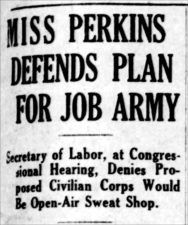 It was Secretary Perkins who “had to go up on the Hill and testify as the principal representative of the President in this field, explaining to Congress before whom the bill was to be heard.”
It was Secretary Perkins who “had to go up on the Hill and testify as the principal representative of the President in this field, explaining to Congress before whom the bill was to be heard.”
March 23, 1933, was her first appearance before “a large Congressional committee”. The attendance of Mrs. Roosevelt further added to the interest and crowds of newspaper men, women and photographers. When Perkins stood before the committee to testify on the merits and validity of the CCC as a relief program, not a job program, the chair she had occupied while awaiting her turn was quickly taken by a spectator.
Her testimony and answering of questions, under sweltering klieg and flash lights, dragged on for close to two hours; an experience she described as “exhausting.”
When the session was over Perkins learned that her testimony was well received even though one Congressman, “had also said after I testified on the CCC Bill that I’d made a good appearance, but he’d hate to be married to me.”
CCC Bill Passes
Senate bill S. 598 authorizing the Emergency Conservation Works (ECW) program was introduced March 27, 1933. The measure passed both houses of Congress and was on the President’s desk to be signed. FDR gave his formal approval with Executive Order 6101 on April 5, 1933.
On April 17, 1933, less than five weeks after FDR put the idea in motion, and tasked his cabinet with “this great brainstorm” the first camp, Camp Roosevelt in the George Washington National Forest in Luray, Virginia, was occupied.
The CCC, lasted 9 1/2 years, 1933 – 1942, it became the most popular and FDR’s favorite New Deal program.
Closest Adviser
Frances Perkins would remain in her position as Secretary of Labor and among FDR’s closest advisers and confidants until his death in 1945. Secretary Perkins would be responsible for many of its programs, among them was the framework and implementation of the Social Security Act, unemployment insurance, child labor laws along with the Fair Labor Standards Act (FSLA) which guarantees maximum work hours and minimum wage.
———————————————————–
This excerpt is taken from the recently published book on the CCC art program and a brief history of the CCC Worker statue by Kathleen Duxbury:
CCC ART – Reima Victor Ratti – Artists of the Civilian Conservation Corps.
Kathleen Duxbury is a Civilian Conservation Corps author, researcher and historian. Her column, CCC New Deal Women, focuses on the little known or untold stories of New Deal women associated with the CCC program. Kathleen has also worked closely with three collaborating organizations The Frances Perkins Center, The Living New Deal and The National New Deal Preservation Association with their 2019 educational publication Women and the Spirit of the New Deal.
